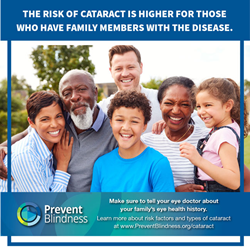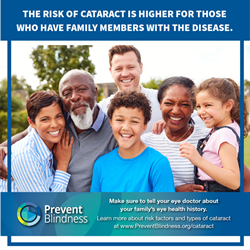
Prevent Blindness declares June as Cataract Awareness Month.
“Although cataract is the world’s leading cause of vision loss, it is an eye disease that can be treated successfully with access to quality eyecare services,” said Jeff Todd, president and CEO of Prevent Blindness.
CHICAGO (PRWEB)
May 21, 2020
Cataract is the world’s leading cause of blindness, accounting for approximately 42 percent of all cases of blindness in all nations. In the United States, more than 25 million Americans are estimated to have cataract, according to the report “Future of Vision: Forecasting the Prevalence and Costs of Vision Problems.” As the population in America continues to age, the number of cataract cases are projected to increase by 50 percent to 38.5 million by 2032.
Prevent Blindness, the nation’s oldest eye health and safety non-profit organization, has declared June as Cataract Awareness Month to educate the public on symptoms, types of cataract, cataract surgery and more.
A cataract is a clouding of the eye’s lens, which blocks or changes the passage of light into the eye. The lens of the eye is located behind the pupil and the colored iris, and is normally transparent. Vision may become blurry or dim because the cataract stops light from properly passing through to the retina. Generally, a cataract does not cause pain, redness or tears.
Risk factors for cataracts include:
- Older age
- Intense heat or long-term exposure to UV rays from the sun
- Certain diseases, such as diabetes
- Inflammation in the eye
- Hereditary influences
- Events before birth, such as German measles in the mother
- Long-term steroid use
- Eye injuries
- Eye diseases
- Smoking
Although most cataract cases in the United States are in older adults, children may also develop pediatric cataracts. According to the American Academy of Ophthalmology, cataracts in a child can be congenital (present at birth) or acquired (develop after birth). Without treatment, cataracts in young children can cause poor development of the visual pathway between the brain and the eye, leading to vision impairment. Therefore, diagnosing and treating cataracts early in children is critical to promoting normal vision development.
“Although cataract is the world’s leading cause of vision loss, it is an eye disease that can be treated successfully with access to quality eyecare services,” said Jeff Todd, president and CEO of Prevent Blindness. “We strongly encourage everyone to educate themselves on cataract and what services are available to see clearly today and in the years to come.”
For free information on cataract, please call Prevent Blindness at (800) 331-2020 or visit the Prevent Blindness website at http://preventblindness.org/cataract/. For a listing of vision care financial assistance programs in English or Spanish, visit https://preventblindness.org/vision-care-financial-assistance-information/.
About Prevent Blindness
Founded in 1908, Prevent Blindness is the nation’s leading volunteer eye health and safety organization dedicated to fighting blindness and saving sight. Focused on promoting a continuum of vision care, Prevent Blindness touches the lives of millions of people each year through public and professional education, advocacy, certified vision screening and training, community and patient service programs and research. These services are made possible through the generous support of the American public. Together with a network of affiliates, Prevent Blindness is committed to eliminating preventable blindness in America. For more information, or to make a contribution to the sight-saving fund, call 1-800-331-2020. Or, visit us on the Web at preventblindness.org or facebook.com/preventblindness.
Share article on social media or email:

